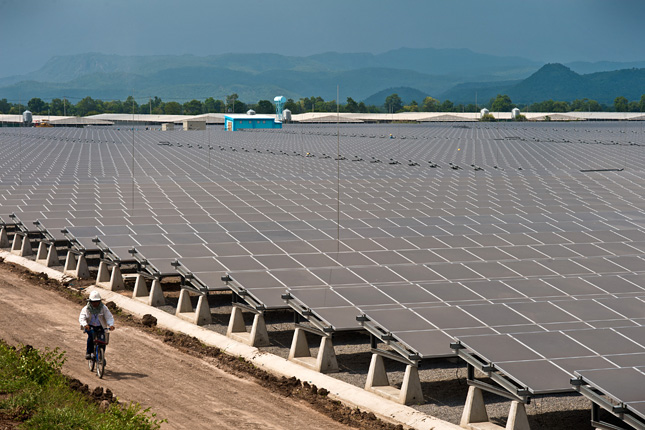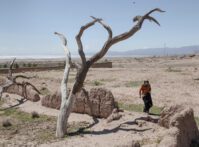-
From Brown to Green: Three Scenarios for a Southeast Asian Regional Energy Grid

Southeast Asia is one of the fastest growing energy markets in the world. Regional demand for energy may grow by as much as 80 percent and electricity demand more than triple by 2040. To keep up, governments are working to expand coordination across borders and create a broader regional energy grid (indeed their efforts predate their northern neighbors’ recent announcement of a “supergrid” by several decades).
From July 12 to 15, officials gathered in Nay Pyi Taw, Myanmar, for the 34th energy Senior Officials Meeting of the Association of Southeast Asian Nations, or ASEAN, a regional organization promoting cooperation between 10 states (and two observers) from Myanmar to Indonesia. The meeting is a key part of the lead up to the ASEAN Ministers on Energy Meeting where representatives are expected to discuss progress on the 2016-2025 ASEAN Plan of Action for Energy Cooperation. A core component of this plan is the establishment of a regional energy marketplace through the development of an ASEAN Power Grid (APG). The APG is comprised of 16 projects, six of which are complete and six more of which are scheduled for completion in 2017.
Bringing this grid online represents a huge stride in ASEAN’s commitment to cooperative growth and regional stability. But keeping the region’s lights on and factories running are not the only pressing issues. How the developing nations of Southeast Asia choose to meet soaring energy demands may prove a redefining force for the region and beyond. Investment in energy infrastructure often means commitments to new, long-term trade contracts for the delivery of energy resources. Given the size of demand, these contracts may roil the geopolitical waters in any number of ways – fostering greater interdependence, increasing economic vulnerability, or even creating opportunities for political power plays.
In addition, the choices made during the development of the APG will be critical to the Paris Convention’s goal of limiting global temperature rise to less than two degrees Celsius. As a region characterized by vulnerabilities to shifting weather patterns, sea-level rise, and crowded urban centers, the stakes for Southeast Asian nations are high.
These issues converge to pose a serious dilemma to ASEAN as it attempts to balance sustainability, economic growth, and national security interests. The APG is the region’s best bet at creating an energy market to deepen regional trade, growth, and integration, but not every development scenario produces win-win outcomes. Three future trajectories are outlined below.
Scenario #1: Brown Energy
According to ASEAN sources, coal accounts for 32 percent (47 gigawatts) of the region’s fuel mix. That percentage is projected to rise to nearly 55 percent (261 gigawatts) by 2035. Coal is abundant and easily exploitable within Southeast Asia. It is resilient against price fluctuations and in 2013 the International Energy Agency concluded it will continue to be the cheapest source of energy for the region at least through 2035.
Choices made during development of the APG will be critical to limiting climate changeFrom a geopolitical standpoint, the exploitation of domestic coal is an attractive proposition as well. Each of the ASEAN countries possesses at least modest domestic coal reserves, even if many are still net importers. Relying on regional coal reserves would hypothetically safeguard sovereignty; limit expensive energy imports from Russia, China, and the Middle East; and guarantee a stable energy supply.
Coal reserves are not limitless, however, and coal consumption garners enormous externalities. Coal threatens to accelerate climate change, exacerbate public health crises, and damage critical ecosystems. Additionally, from a geopolitical standpoint, externally funded coal development projects may allow lending countries an avenue to exercise undesirable political influence. The World Bank’s decision to stop funding fossil-fuel power plants has created a financing void that others have stepped into. Indeed, since 2013, 27 countries have turned to Chinese state-owned enterprises for assistance in developing coal power plants, including six ASEAN members.
Scenario #2: Natural Gas
Natural gas offers the opportunity to break dependence on coal and oil. Natural gas is the least carbon-intensive fossil fuel (not withstanding dangerous and damaging methane leaks) and is abundant throughout North America and the Asia-Pacific. Papua New Guinea, Indonesia, Brunei, and Malaysia are the region’s largest gas producers. Russia, Iran, and Qatar are the leading global suppliers.
The 2016-2025 ASEAN Plan of Action for Energy Cooperation outlines the expansion of a Trans-ASEAN Gas Pipeline to create a wholesale regional natural gas market. The pipeline is currently over 2,000 miles long, stretching from Java to Thailand and Myanmar, with plans to extend it an additional 800 miles to a total distance of 2,800 miles.
As demand for gas outpaces local production capacity, the region is embracing liquefied natural gas (LNG) imports. Converting natural gas to a liquid state allows it to be safely shipped on freighters and transported without pipelines. But before LNG can be burned to generate energy it must be converted back to its gas state, a process that requires costly regasification infrastructure in the importing country. Ultimately, burning local natural gas is more cost effective, while LNG imports are generally price comparable to oil.
Shortfalls in regional gas supplies will continue to necessitate imports, which, although more reliable than oil, come at the risk of supply chain vulnerabilities of their own. ASEAN already accounts for 60 percent of global LNG consumption; additional large shifts may create international security concerns as currency inflows shift away from Saudi Arabia and Iraq to LNG-rich countries like Iran, Qatar, and Russia.
Scenario #3: Green Transition
Green technology is the ultimate frontier for energy security. Not only are green technologies sustainable over the long run, they can leverage micro-grid technologies to produce localized energy absent external reliance. ASEAN countries have already begun to capitalize on isolated grids, but lack the energy infrastructure to incorporate them into the larger energy marketplace. There are several obstacles to overcome.
Too-rapid a transition may intensify emerging power vacuumsFirst, the technologies are not yet mature. Although some countries, like Germany, have made progress in adopting green technologies, gaps during non-peak production times necessitate ongoing subsidization of fossil fuel plants – a luxury emerging economies cannot afford.
Second, the rare earth minerals needed for wind and solar infrastructure come predominantly from China, which could use them as leverage in regional disputes. In 2010, for example, China blocked the trade of rare earth minerals to Japan over maritime disagreements.
Lastly, too-rapid a transition away from fossil fuels may intensify emerging power vacuums and stoke economic turmoil in traditionally fossil fuel-reliant areas such as the Middle East and North Africa.
The Domino Effect
Improving energy security in Southeast Asia presents a classic dilemma of short-term returns verses long-term stability. Coal may be fastest route to energy independence, but comes at the cost of public health and climate change. Natural gas presents an appealing intermediate solution, but requires heavy investment and may force constrictive or uncomfortable relationships. Meanwhile, as the German experiment has shown, green solutions may not be immediately practical even if they promise environmental returns.
ASEAN countries can overcome some of these obstacles by constructing a diversified regional plan. The ASEAN Power Grid is just that. The APG could allow some countries to focus on green technology investments while securing auxiliary energy from existing infrastructure in others. This approach would limit dependence not only on the Middle East, but also relieve some of the current dependence on China. The eventual move from bilateral lines to a truly multilateral trans-boundary grid would also foster a more transparent and efficient energy market capable of more reliable delivery. Additionally, as the APG absorbs isolated or semi-isolated micro grids it will facilitate the transition to green technologies, decrease energy waste, and diversify the region’s energy mix in a more sustainable way.
ASEAN should not lose focus on the theme of its 2016-2025 APAEC: “enhancing energy connectivity and market integration in ASEAN to achieve energy security, accessibility, affordability, and sustainability for all.” It is easy for policymakers to bite off one or two of these objectives while neglecting others. Although coal may promote short-term security, accessibility, and affordability, it is anything but sustainable. The ASEAN Ministers on Energy Meeting should advance APG aims with an eye toward using coal and other brown energy sources as intermediate steps toward a greener – and more self-sufficient – energy economy. Developed economies can assist along the way by marketing green technologies throughout the region.
The window of opportunity is open, but as governments commit to expensive infrastructure, the chance to influence future trajectories in this dynamic region dwindles.
Molly McKeon is a member of the Young Leaders Program at the Pacific Forum, Center for Strategic International Studies. She holds a M.A. in international environmental policy from the Middlebury Institute of International Studies at Monterey and is currently pursuing a research fellowship in Mongolia.
Adam Greer is a WSD-Handa fellow at the Pacific Forum, Center for Strategic International Studies. He holds a M.A. in Asian studies from Georgetown University’s School of Foreign Service and is currently an instructor at the U.S. Air Force Academy.
Sources: ASEAN Center for Energy, Asian Clean Energy Forum, Asia-Pacific Roundtable, Association of Southeast Asian Nations, Bloomberg View, China Daily, Environmental Defense Fund, Global New Light of Myanmar, International Energy Agency, The New York Times, South China Morning Post, U.S. Global Geological Survey.
Photo Credit: The Lopburi solar plant in central Thailand, courtesy of the Asian Development Bank.
Topics: Asia, China, coal, cooperation, development, economics, energy, environment, featured, foreign policy, Guest Contributor, Japan, Middle East, mitigation, Myanmar, natural gas, oil, Russia, solar, wind, World Bank
 A Publication of the Stimson Center.
A Publication of the Stimson Center.






